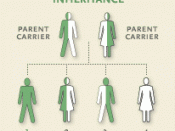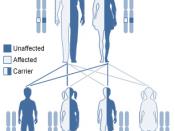Abstract For the most part, modes of inheritance of most traits fall into one of four broad categories including autosomal dominant, autosomal recessive, sex-linked dominant and sex-linked recessive. The mode can easily be determined by following just two to three generations of progeny from a specific cross. In this case, we crossed Drosophila melanogaster, and were able to determine the modes of inheritance for three different traits after observing results of the F1 generation. The parental generation consisted of flies that were completely homozygous for either wild-type or mutant traits. An F2 generation was obtained by selfing the F1 flies. Doing a reciprocal cross for every generation was of utmost importance as it immediately elucidated the presence of sex-linked traits. This is because if different results are obtained from the reciprocal crosses, it can be inferred that we are dealing with a sex-linked trait. Relying heavily on basic Mendelian principles of dominance and segregation, Punnett squares were used to yield simple ratios that were used predict the outcome of the phenotypic ratios of the F2 generation.
In this way it was determined that the mutation for black bodies was autosomal and recessive while the mutations for eye-color and bristle structure were X-linked recessive. Actual results of progeny were tested against our predicted ratios using the ÷2 test and although the outcome was not always as expected, I am certain that further testing can prove that these are truly the correct modes of inheritance.


